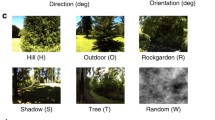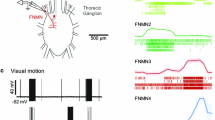Summary
A high-order wide-field neuron in the optic lobe of the fly,Phormia terraenovae (Calliphoridae), has been investigated by stimulation with simple or multiple black stripes on a white background moving sinusoidally towards and away from the head. The variation in spike frequency in correlation with the optical stimulation provides evidence that the unit detects angular velocity as well as more complex features of the stimulus. It responds preferentially to movement towards the head. Spike frequency turned out to be a two-valued function of relative angular velocity across the eye. A simple formula predicts the highly reliable responses to visual stimuli in different parts of the visual field.
Similar content being viewed by others
References
Dvorak, D.R., Bishop, L.G., Eckert, H.E.: On the identification of movement detectors in the fly optic lobe. J. Comp. Physiol.100, 5–23 (1975)
Eckert, H.E.: Response properties of dipteran visual interneurons involved in control of optomotor behaviour. Nature (London)271, 358–360 (1978)
Eckert, H.E., Bishop, L.G.: Anatomical and physiological properties of the vertical cells in the third optic ganglion ofPhaenicia sericata (Diptera, Calliphoridae). J. Comp. Physiol.126, 57–86 (1978)
Eriksson, E.S.: A theory of veridical space perception. Scand. J. Psycho).15, 225–235 (1974)
French, A.S., Järvilehto, M.: The transmission of information by first and second order neurons in the fly visual system. J. Comp. Physiol.126, 87–96 (1978)
Glantz, R.M.: Defense reflex and motion detector responsiveness to approaching targets: The motion detector trigger to the defense reflex pathway. J. Comp. Physiol.95, 297–314 (1974)
Hausen, K.: Functional characterization and anatomical identification of motion sensitive neurons in the lobula plate of the blowflyCalliphora erythrocephala. Z. Naturforsch.31, 629–633 (1976)
Horridge, G.A.: The compound eye and vision in insects. Oxford: Clarendon Press 1975
Pierantoni, R.: A look into the cock-pit of the fly. Cell Tissue Res.171, 101–122 (1976)
Schlotterer, G.R.: Response of the locust descending movement detector neuron to rapidly approaching and withdrawing visual stimuli. Can. J. Zool.55, 1372–1376 (1977)
Strausfeld, N.J.: Atlas of an insect brain. Berlin, Heidelberg, New York: Springer 1976
Taddei Ferretti, C., Fernandez Perez de Talens, A.: The effect of illumination on the landing response. In: The compound eye and vision in insects. Horridge, G.A. (ed.), pp. 502–514. Oxford: Clarendon Press 1975
Zeltler, F., Weiler, R.: Neural principles of vision. Berlin, Heidelberg, New York: Springer 1976
Author information
Authors and Affiliations
Additional information
The author wants to thank Professor G. A. Horridge for his valuable support and clarifying discussions and to Dr. M. Srinivasan for his comments. The project has been supported by grants from the Swedish Council for Natural Science Research.
Rights and permissions
About this article
Cite this article
Eriksson, E.S. Responses of visual interneurons in the fly optic lobe during stimulation by motion in depth. J. Comp. Physiol. 141, 123–130 (1980). https://doi.org/10.1007/BF00611885
Accepted:
Issue Date:
DOI: https://doi.org/10.1007/BF00611885




